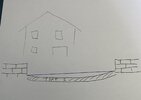Yet another block paving question I’m afraid.
A few years ago I put type 1 down on my drive and compacted it, but left it as-is. I’m now looking at block paving it and getting my edgings and levels in place, but the natural contour of the type1 is a bit “dished” ie the sides have a slight bank upwards. This hasn’t really struck me as being a problem, as it’s the natural lie of the ground, but I’m now wondering if this is a bad idea and I should try and build things up to make a completely flat plain? I guess screeding is easier if I did it that way, but presumably still possible with a bit of a contour? Either way, I think the footpath at the boundary will still follow a bit of a dipped line.
A few years ago I put type 1 down on my drive and compacted it, but left it as-is. I’m now looking at block paving it and getting my edgings and levels in place, but the natural contour of the type1 is a bit “dished” ie the sides have a slight bank upwards. This hasn’t really struck me as being a problem, as it’s the natural lie of the ground, but I’m now wondering if this is a bad idea and I should try and build things up to make a completely flat plain? I guess screeding is easier if I did it that way, but presumably still possible with a bit of a contour? Either way, I think the footpath at the boundary will still follow a bit of a dipped line.



